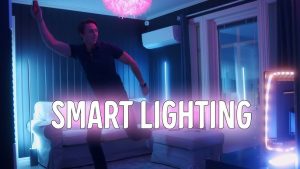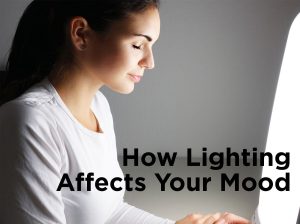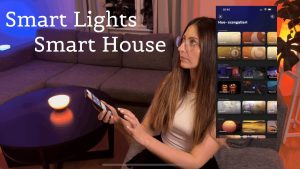Introduction
When it comes to creating the right atmosphere at home, lighting plays a key role in shaping your environment. The right lighting can improve your mood, help you focus, and even aid in better sleep. In 2025, smart lighting has brought home decor to a new level. With technology, you can adjust the lighting to fit any situation, whether you’re working, relaxing, or getting ready for bed.
In this article, we’ll discuss how adaptive lighting can improve your mood and sleep, and share simple ways to make your home a peaceful space for both body and mind. With adaptive lighting, you can create a relaxing and calm environment with just a few taps.
What is Smart Lighting?

Smart lighting refers to light bulbs or fixtures that you can control from your smartphone, tablet, or with voice commands using a smart assistant like Amazon Alexa or Google Assistant. These lighting systems do more than just turn the lights on or off—they let you change the brightness, colors, and settings to fit different times of the day or activities.
With adaptive lighting, you can set warm, soft lights to relax or bright, cool lights to help you focus. For improving mood and sleep, smart lighting can sync with your natural sleep-wake cycle, known as the circadian rhythm.
How Smart Lighting Affects Mood

Lighting does more than just light up a room it can impact your feelings and health. Here’s how adaptive lighting can lift your mood:
1. Light Temperature Matters
The warmth of light affects how we feel. Warm light (around 2700K) helps you feel calm, making it perfect for relaxing areas like your bedroom or living room. On the other hand, cool light (5000K or higher) is great for staying alert and focused, ideal for places like your office or kitchen.
Smart lighting lets you easily change the light’s temperature to fit your mood or activity, whether you want to relax or get things done.
2. Adjusting Brightness for Different Activities
The brightness of light also changes how we feel. Dimmer light creates a cozy atmosphere, perfect for unwinding. Brighter light helps with focus and tasks like reading or cooking.
With adaptive lighting, you can adjust the brightness using your smartphone or voice commands, giving you control over the environment.
3. Creating Color Ambiance
Smart lighting lets you change the color of the lights to match your mood. For example, blue light can calm you, while yellow and orange create a warm, welcoming atmosphere. Experimenting with different colors can help improve your mood.
Studies suggest certain colors can affect mental health green light can reduce stress, and red light can make you feel relaxed.
How Smart Lighting Improves Sleep Quality

Smart lighting is great for improving sleep quality. The lighting in your home can help set the right time to sleep and wake up. Here’s how adaptive lighting can help you sleep better:
1. Simulating Natural Light
Our bodies respond to sunlight, which helps set our internal clock. Smart lighting can simulate daylight in your home. You can set your lights to gradually brighten in the morning like a sunrise, helping you wake up naturally. In the evening, you can dim the lights and change them to warm tones to help signal it’s time for sleep.
2. Reducing Blue Light Exposure at Night
Blue light from devices like phones and tablets can stop you from falling asleep by affecting melatonin, a hormone that controls sleep. Adaptive lighting can automatically switch to warmer tones at night to reduce blue light and help you wind down for sleep.
3. Enhancing Sleep-Inducing Environments
A dark, quiet, and cool environment is ideal for sleep. Adaptive lighting can help create this by dimming the lights at bedtime, helping your body relax. Some systems can sync with other devices, like your thermostat or white noise machine, to create the perfect sleep environment.
Future of Smart Lighting Ideas at Home

The future of smart lighting looks bright and full of promise. As technology advances, these systems will become smarter and more responsive. Future lights may automatically adjust based on your activities and even monitor your sleep patterns to give better suggestions. Innovations might also make the systems more affordable and easier to install. With ongoing improvements, adaptive lighting is set to play an even larger role in creating healthy and comfortable homes. Homeowners can look forward to a future where light settings improve mood and sleep quality effortlessly, making every day a bit brighter and more restful.
Comparative Table: Smart Lighting Options for Different Purposes
| Purpose | Recommended Lighting Type | Color Temperature (Kelvin) | Brightness |
|---|---|---|---|
| Mood Lighting | Soft, warm lighting | 2700K to 3000K | Low |
| Work and Productivity | Bright, cool lighting | 5000K to 6500K | High |
| Relaxation | Warm, soft lighting | 2700K to 3000K | Medium |
| Sleep Quality | Amber or red light | 2200K to 2500K | Low |
| Morning Wake Up | Gradual brightening | 5000K to 6000K | High |
Conclusion
Smart lighting is changing how we set the mood and control the ambiance of our homes. By adjusting the color, brightness, and temperature of your lights, you can significantly improve your mood and sleep quality. In 2025, adaptive lighting systems are more affordable and accessible, making it easier for anyone to create a personalized environment for relaxation, focus, and rest.
Whether you’re creating a calm atmosphere for a good night’s sleep or energizing your space during the day, adaptive lighting offers a simple solution to enhance your well-being. Upgrade your lighting system and make your home healthier and more comfortable.










